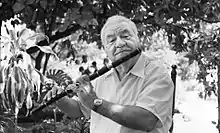Antonio Arcaño | |
|---|---|
 Antonio Arcaño in 1970. | |
| Background information | |
| Birth name | Antonio Arcaño Betancourt |
| Born | 29 December 1911 Havana, Cuba |
| Died | 1994 (aged 82–83) |
| Genres | Danzón |
| Occupation(s) |
|
| Instrument(s) | Flute |
Antonio Arcaño Betancourt (Atarés, Havana 29 December 1911 – 1994) was a Cuban flautist, bandleader and founder of Arcaño y sus Maravillas, one of Cuba's most successful charangas. He retired from playing in 1945, but continued as director of the group until its dissolution in 1958.[1][2] Despite his early retirement due to health problems, he is considered one of the most influential flautists in Cuba.[3]
After leaving La Maravilla del Siglo, a very popular charanga, Arcaño founded La Maravilla de Arcaño, later known as Arcaño y sus Maravillas. The band featured the López brothers, Israel López "Cachao" and Orestes López, composers and multi-instrumentalists that originated the danzón-mambo, the direct precursor of the mambo, through compositions such as "Rareza de Melitón", "Se va el matancero" and, above all, "Mambo", the piece that lent its name to the genre.[4][5] Arcaño was posthumously inducted into the International Latin Music Hall of Fame in 2000.[6]
See also
References
- ↑ Miller, Sue (2013). Cuban Flute Style: Interpretation and Improvisation. Lanham, MD: Scarecrow Press. p. 71. ISBN 9780810884427.
- ↑ Díaz Ayala, Cristóbal (Fall 2013). "Orquesta Maravilla de Arcaño" (PDF). Encyclopedic Discography of Cuban Music 1925-1960. Florida International University Libraries. Retrieved 28 September 2018.
- ↑ Orovio, Helio (2004). Cuban Music from A to Z. Bath, UK: Tumi Music. p. 17. ISBN 9780822385219.
- ↑ Conzo, Joe; Pérez, David A. (2010). Mambo Diablo: My Journey With Tito Puente. Bloomington, IN: Authorhouse. p. 81. ISBN 9781452082813.
- ↑ Acosta, Leonardo (2006). "La realidad sobre la descarga". Otra visión de la música popular cubana (in Spanish). Barranquilla, Colombia: La Iguana Ciega.
- ↑ "International Latin Music Hall of Fame Announces Year 2000 Inductees". 1 March 2000. Retrieved 31 October 2015.